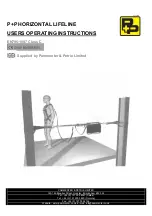
17
INSTALLATION AND OPERATION INSTRUCTIONS — FENCE PROTECTION SYSTEMS
Additional Sources of Nuisance Alarms
Further inspection may disclose some of the following conditions that may need correcting:
Cables, pipes, wires, other fences, limbs, bushes, flagpoles, etc., that may move in the wind and
transfer vibrations to the fence.
Normal gate operations during protected hours if there is no gate shunt.
Condition of the fabric, i.e., old, rusty, loose, rough, and excessive galvanizing material.
NOTE:
Spending the time and attention on the fence conditions noted above will
result in an efficient and reliable system. Ignoring these sources of nuisance alarms will
result in call backs and poor system performance.
Fence Quieting
Section 2 states that once the FPS system is installed on the fence, the FPS and the fence become the
alarm system. Therefore, noises generated on the fence can be a major cause of nuisance alarms.
However, they do not have to be.
During transducer cable installation, while the work crew is walking the entire length of the perimeter
fence, some simple fence quieting action will usually make the operational testing and system check-
out go more smoothly.
Major defects in a fence installation will cause fence alarm problems. The major problems should be
corrected by a fence contractor. But there are many small problems that can be quickly corrected
using your ear, eye, and some black ultraviolet resistant cable ties. Proceed as follows:
Step 1. Walking the perimeter fence, grab the fence fabric in the center of each fence section. Pull the
fence fabric toward you as far as practical and let go.
Step 2. Listen for noises that sound like metal hitting metal. Typical sounds are clanging, ticking,
tapping, etc. The metal-to-metal sounds could be interpreted as counts by the FPS system.
Step 3. Carefully observe where these noises are coming from. Undoubtedly, a loose piece of metal, a
loose fence tie, an improperly tied stiffener, etc., is causing the problem.
Step 4. Tie the loose item in place using the cable ties. Continue to tie off the noise makers until the
fence section is quiet. Continue quieting the fence until all fence panels are quiet.















































